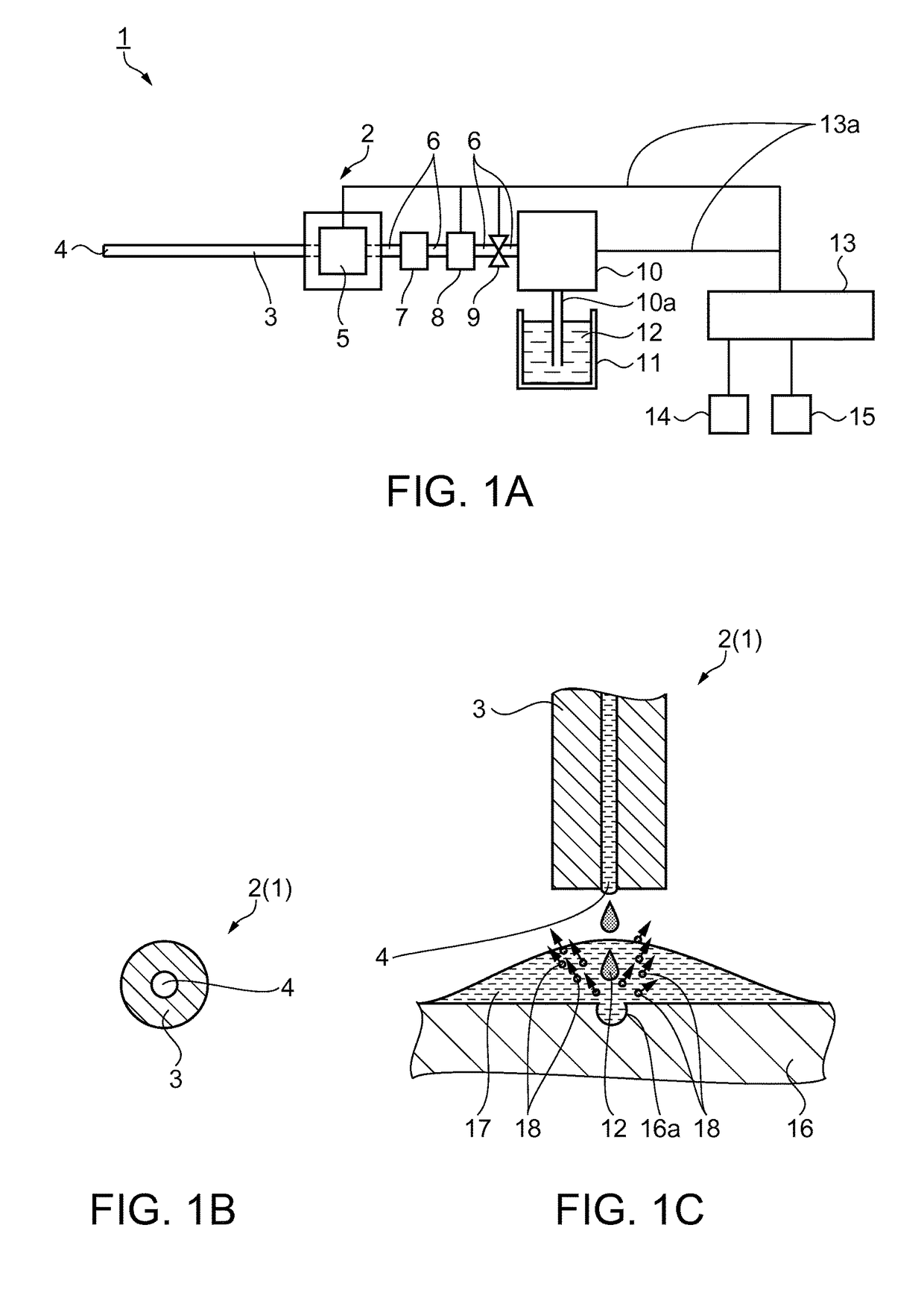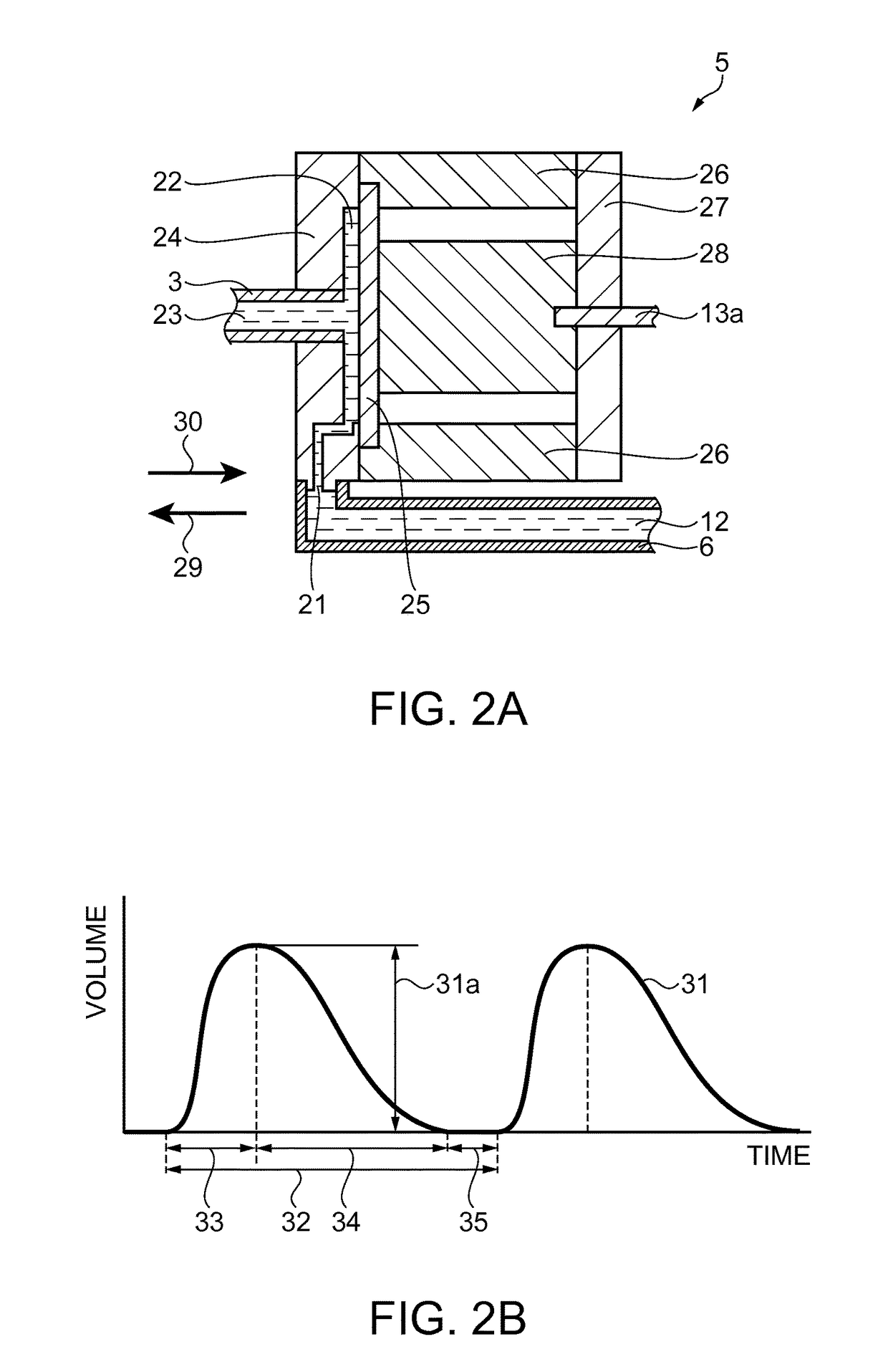Cellular tissue dissection method and liquid ejection device
a cell tissue and liquid ejection technology, applied in the field of cell tissue dissection methods and liquid ejection devices, can solve the problems of fatigue fractures that can occur more easily in the part connecting cells together, and it is difficult to control the depth to which the cellular tissue is dissected
- Summary
- Abstract
- Description
- Claims
- Application Information
AI Technical Summary
Benefits of technology
Problems solved by technology
Method used
Image
Examples
first embodiment
[0029]In this embodiment, a liquid ejection device as a surgical apparatus will be described with reference to FIGS. 1A to 5D. FIG. 1A is a block diagram showing the configuration of the liquid ejection device. FIG. 1B is partial schematic side view showing the structure of a nozzle in the liquid ejection device. The liquid ejection device 1 of this embodiment is a medical apparatus used in a medical institution and has the function of a surgical knife which ejects a fluid to an affected part and thus incises or excises the affected part. The liquid ejection device 1 can also be used for treatment and autopsy of other animals than humans.
[0030]As shown in FIG. 1A, the liquid ejection device 1 has a handpiece 2. The handpiece 2 is a device which the surgical operator holds in his / her hand and operates when carrying out a surgical operation. In other situations than surgical operation, the surgical operator is also referred to as an operator. An ejection tube 3 that is a channel for a...
second embodiment
[0072]Next, an embodiment of a liquid ejection device will be described with reference to the block diagram of FIG. 6 showing the configuration of the liquid ejection device.
[0073]This embodiment is different from the first embodiment in that the pulsation applying part 5 of FIG. 1A is eliminated. The same features as in the first embodiment will not be described further.
[0074]That is, in this embodiment, in a liquid ejection device 62, the tube 6 is connected with the ejection tube 3, as shown in FIG. 6. As the surgical operator turns on the ejection switch 15, the liquid 12 is continuously ejected from the nozzle 4. Again, when the cellular tissue 16 can be dissected, a configuration without the pulsation applying part 5 may be employed. Since the pulsation applying part 5 and the pulsation control unit 50 can be omitted, the liquid ejection device 62 that can be easily manufactured is provided.
third embodiment
[0075]Next, an embodiment of a liquid ejection device will be described with reference to the block diagram of FIG. 7 showing the configuration of the liquid ejection device.
[0076]This embodiment is different from the first embodiment in that an edge portion 64 is installed near the nozzle 4. The same features as in the first embodiment will not be described further.
[0077]That is, in this embodiment, in a liquid ejection device 63, the edge portion 64 is installed on the ejection tube 3, as shown in FIG. 7. Thus, the surgical operator can form the incision 56 on the surface of the cellular tissue 16 and eject the liquid 12 toward the incision 56 from the nozzle 4. Since the liquid ejection device 63 has the edge portion 64, the surgical operator can carry out both the formation of the incision 56 and the ejection of the liquid 12, using the liquid ejection device 63. Therefore, since the surgical operator need not hold a plurality of tools one after another, the cellular tissue 16 c...
PUM
 Login to View More
Login to View More Abstract
Description
Claims
Application Information
 Login to View More
Login to View More - R&D
- Intellectual Property
- Life Sciences
- Materials
- Tech Scout
- Unparalleled Data Quality
- Higher Quality Content
- 60% Fewer Hallucinations
Browse by: Latest US Patents, China's latest patents, Technical Efficacy Thesaurus, Application Domain, Technology Topic, Popular Technical Reports.
© 2025 PatSnap. All rights reserved.Legal|Privacy policy|Modern Slavery Act Transparency Statement|Sitemap|About US| Contact US: help@patsnap.com



